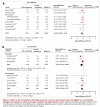Efficacy of self-monitoring of blood glucose in patients with type 2 diabetes mellitus managed without insulin: a systematic review and meta-analysis
- PMID: 21686299
- PMCID: PMC3116681
Efficacy of self-monitoring of blood glucose in patients with type 2 diabetes mellitus managed without insulin: a systematic review and meta-analysis
Abstract
Background: Self-monitoring of blood glucose levels is commonly performed by patients with diabetes mellitus. However, there is debate surrounding the clinical utility and cost-effectiveness of this practice among patients with type 2 diabetes managed without insulin. We conducted a systematic review and meta-analysis to determine the effect of self-monitoring versus no self-monitoring, and the optimal frequency of self-monitoring, in this population.
Methods: MEDLINE, EMBASE, BIOSIS Previews, CINAHL and PsycINFO were searched for randomized controlled trials (RCTs) and observational studies published in English from January 1990 to March 2009. Additional citations were obtained through searches of the Internet and conference proceedings, and from stakeholder feedback. Two reviewers independently selected studies, extracted data and performed an assessment of the methodologic quality of the studies. Key outcomes of interest were hemoglobin A1c (HbA(₁c)) concentration, hypoglycemia, quality of life, long-term complications of diabetes and death. Where appropriate, we pooled data using random-effects meta-analysis.
Results: We identified 1624 citations through the literature search and selected 25 articles for inclusion. We observed a statistically significant improvement in the HbA(₁c) concentration across RCTs that compared self-monitoring of blood glucose levels with no self-monitoring among patients taking oral antidiabetes drug therapy (weighted mean difference --0.25%, 95% confidence interval -0.36% to -0.15%). Subgroup analysis indicated that results from RCTs that provided patients with education on how to interpret and apply self-monitoring test results were similar to those from RCTs that did not. On the basis of limited evidence, self-monitoring of blood glucose levels did not demonstrate consistent benefits in terms of quality of life, patient satisfaction, prevention of hypoglycemia or long-term complications of diabetes, or reduction of mortality. There was insufficient evidence pertaining to the optimal frequency of self-monitoring.
Interpretation: Self-monitoring of blood glucose levels was associated with a modest, statistically significant reduction in hemoglobin A1c concentrations, regardless of whether patients were provided with education on how to interpret and use the test results. Further studies are required to determine whether self-monitoring reduces the risk of long-term complications of diabetes and to identify patients most likely to benefit from self-monitoring.
Conflict of interest statement
Competing interests: Marshall Dahl has received an honorarium of less than $5000 from Eli Lilly Canada Inc. for his work related to workshops. He has also received an arm’s-length grant from GlaxoSmithKline Inc. for a diabetes study involving patients with coronary artery disease. Brendan McIntosh, Changhua Yu, Avtar Lal, Kristen Chelak, Chris Cameron and Sumeet Singh have no personal or financial competing interests related to this project.
Figures









Comment in
- Butalia Sonia, Rabi Doreen M. To test or not to test? Self-monitoring of blood glucose in patients with type 2 diabetes managed without insulin. Open Med. 2010;4(2):e114–e116. http://www.openmedicine.ca/article/view/400/330.
References
-
- UK Prospective Diabetes Study Group. Tight blood pressure control and risk of macrovascular and microvascular complications in type 2 diabetes: UKPDS 38. BMJ. 1998;317(7160):703–713. http://bmj.com/cgi/pmidlookup?view=long&pmid=9732337. - PMC - PubMed
-
- Canadian Diabetes Association 2008 clinical practice guidelines for the prevention and management of diabetes in Canada. Can J Diabetes. 2008;32(Suppl 1):S1–S201. http://www.diabetes.ca/files/cpg2008/cpg-2008.pdf. - PubMed
-
- Report from the National Diabetes Surveillance System: diabetes in Canada, 2008. Ottawa: Public Health Agency of Canada; [accessed 2010 Apr 8]. http://www.phac-aspc.gc.ca/publicat/2008/ndssdic-snsddac-08/index-eng.php.
-
- The prevalence and costs of diabetes. Toronto: Canadian Diabetes Association; 2007. [accessed 2010 Apr 8]. http://www.diabetes.ca/Files/prevalence-and-costs.pdf.
-
- Schütt M, Kern W, Krause U, Busch P, Dapp A, Grziwotz R, Mayer I, Rosenbauer J, Wagner C, Zimmermann A, Kerner W, Holl R W DPV Initiative. Is the frequency of self-monitoring of blood glucose related to long-term metabolic control? Multicenter analysis including 24,500 patients from 191 centers in Germany and Austria. Exp Clin Endocrinol Diabetes. 2006;114(7):384–388. doi: 10.1055/s-2006-924152. - DOI - PubMed
LinkOut - more resources
Full Text Sources
Miscellaneous
